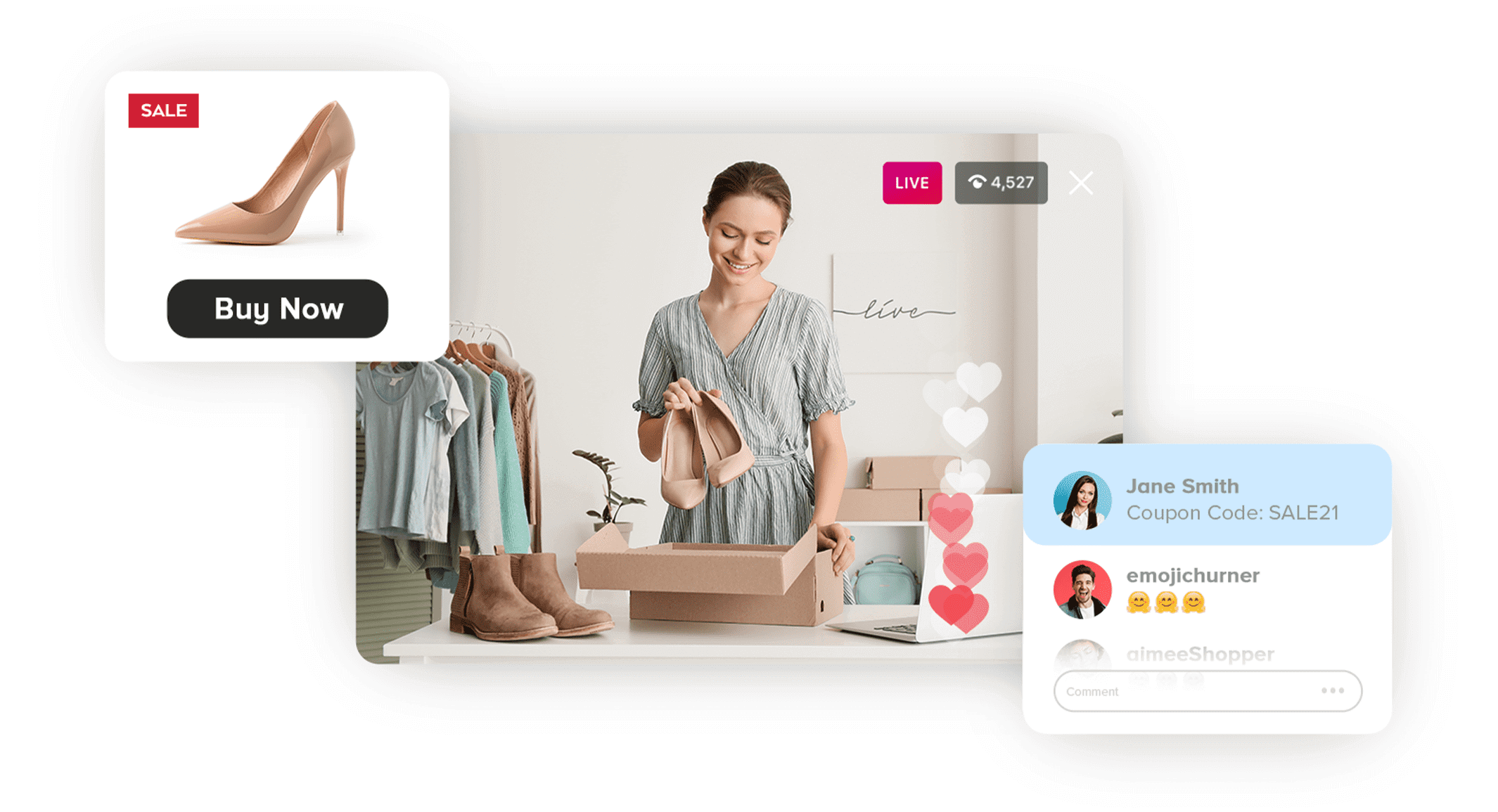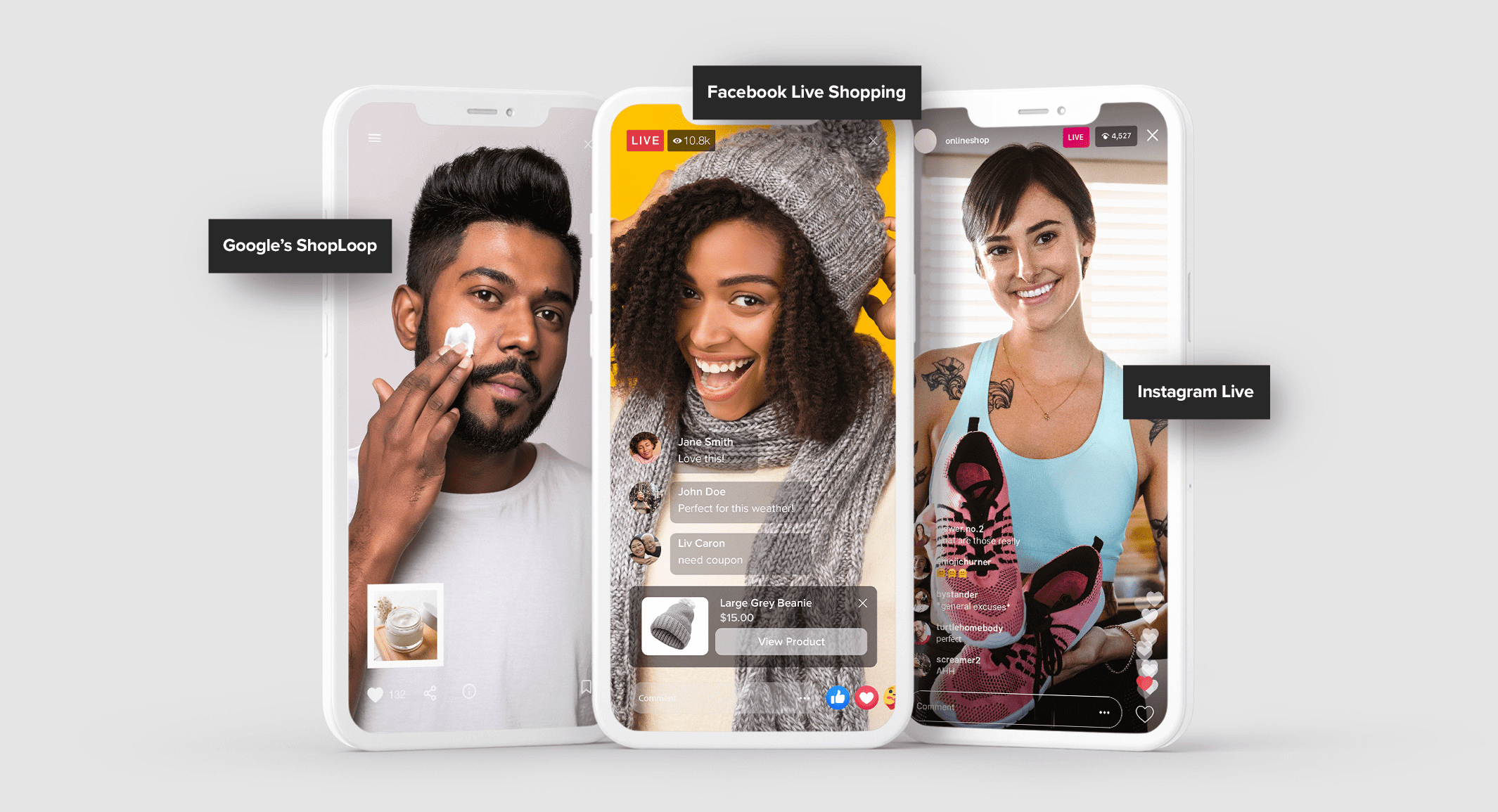Live Shopping: Revolutionizing the eCommerce Experience
What is Live Shopping?
Live shopping has generated significant interest in the last year as the newest and latest trend in eCommerce. The integrated experience allows users to simulate in-store buying by providing a platform for live, guided retail reminiscent of television shopping channels beloved by many since the 1980s.
Live shopping allows consumers to watch a stream, interact with the host and other viewers, and purchase the featured product seamlessly within a single platform. It gives brands the unique ability to educate consumers about new and upcoming products in real time, minimizing pain points typically found throughout multi-platform online shopping and social commerce.
Live eCommerce replaces the traditional online purchasing experience by eliminating various friction points stemming from the inability to access product information, see reviews, watch tutorials, and complete a purchase in one place. Streams allow consumers to view the product in action, get real time reviews from the host and attendees, and purchase within a single window. The customer journey is shortened and simplified, ultimately providing built-in conversion opportunities that require minimal user effort.
How Live Stream Commerce Works
The goal of live shopping is to turn viewers into buyers. Brands interested in pursuing live shopping have no shortage of implementation options—live commerce features are becoming increasingly common both via existing social media platforms and third party applications. Viewers tune into a live stream for access to unique content and the ability to interact with the host and other shoppers. They are met with the ability to ask questions, share reviews, and ultimately make purchases within the stream via eCommerce integrations or product links. Brands are able to generate significant revenue attributed to live shopping, with third-party platform Livescale reporting a 9.5% conversation rate made possible thanks to frictionless checkout.
In order to begin leveraging the live experience, brands need a host (often accomplished through influencer partnerships), a product feed or product links, and an ability to stream video in real time. Live streams increase audience engagement and are most effective when paired with limited time offers, product launches, or giveaways to incentivize viewers and create a sense of urgency, exclusivity, and community within the experience.
What are the benefits?
Some of the perks of live shopping include:
- Owned revenue attributed to specific streams and hosts
- Appeal to the instant gratification expected by modern consumers
- An interactive space that allows for real-time product visualization, feedback, and engagement
- Organizations can foster a meaningful connection with their consumers, by interacting with brand ambassadors
The most prominent challenge brands will face is finding suitable influencers and hosts for live shopping streams. Influencer partnerships are extremely impactful when done right, although facilitating the perfect influencer and brand match is not always straightforward.
How Live Commerce Contributes to the Omnichannel Experience
Consumers are searching for an omnichannel retail experience now more than ever. With shopping behaviour migrating online at a rapid rate, the demand for a more personalized, virtual “in-store” experience is magnified. Live commerce allows consumers to enjoy the brick-and-mortar experience from the comfort of their own homes—a notable advancement for the retail industry as a whole.
Live shopping offers a retail solution that harmonizes the advantages of in-store and online shopping. The live commerce purchase journey provides a more seamless experience than the typical online store, aggregating various touch points into one platform to minimize complexity. It also offers engagement and human interactions valued by those who prefer brick-and-mortar shopping. This digital transformation solution will help enterprises enhance their omnichannel presence and has proven itself to be a powerful tool when paired with other digital and traditional strategies.
How will live shopping affect eCommerce in 2021?
As large organizations like Amazon and Google start to launch their own live shopping platforms, the eCommerce landscape will continue to shift to accommodate. Fostering a connection between brand and consumer will continue to be an integral part of retail strategies this year as shoppers seek an immersive experience from start to finish. Fashion and beauty industries will continue to lead the conversation—major brands in this space already rely heavily on influencer streams to drive revenue, making live commerce an almost effortless next step in their retail strategy. Fashion and beauty industries also benefit from products well-suited for tutorials, demonstrations, and other streamable content. Consumers can expect to see big social media platforms, notably Instagram and YouTube, dominating the live shopping landscape in 2021.
With influencer marketing remaining a powerful marketing tool in many industries, the live shopping experience has the potential to combine influencer strategy with flash deals and product launches to drive purchases. A new take on VIP treatment, live shopping creates a personalized environment where consumers are able to contribute to the experience, engage with other shoppers, and be rewarded for purchasing during the stream. Expect to see an explosive growth in influencer-led live streams as the live eCommerce trend continues to increase in popularity.
Live Shopping Platforms
Live shopping is available both through existing social media and third-party platforms. For a comprehensive list of available live commerce platforms, check out these 13 platforms for shoppable videos.
Brands turning to third-party options such as Livescale, available to all North American Shopify Merchants, will find all of these features and more. Add-ons not yet available within native experiences, such as gamification features designed to target impulse buyers, will improve the user experience and maximize conversions. Third-party options have also minimized user actions required to purchase, allowing customers to buy directly within the video experience. Livescale offers seamless branded experiences encompassing chat monitoring, analytics, and brand administration control panels supporting increased optimization opportunities for brands.
Among the most popular of the native live shopping integrations is Facebook Live Shopping, which allows brands with active Commerce Accounts (must have Commerce Manager, a linked Facebook Page, and products set in Facebook Catalog) to tag and feature product links directly from their catalog. For brands using Facebook without Commerce accounts, there is an option within the platform to manually add product links before going live.
Instagram launched a Live Shopping feature in 2020 as a natural expansion of the past years’ shopping and checkout feature launches. Although available only to American brands and creators on the platform, Instagram Live Shopping allows the host to create a collection of up to 30 products for showcasing in the stream and pinning one item at a time while Live to feature that product. This update marks an intuitive next phase of Instagram Shopping, which currently offers in-app shopping, product tags and detail pages, linked ads, and in-app checkout. The ability to easily monetize content and direct qualified traffic to integrated storefronts is on par with industry competitors—TikTok’s partnership with Shopify has already resulted in shopping integrations and beta versions of live social commerce features seen on other platforms.
Tech giant Google has launched a similar platform called ShopLoop, allowing users to discover, evaluate, and buy products all in one place. Despite videos not being live, ShopLoop mimics popular social media platforms like TikTok and Instagram Reels by leveraging 90-second videos to showcase and sell products, adding an integrated eCommerce feature for one-click purchasing. This is a trend to watch as ShopLoop continues to grow and launch in new spaces—a live integration here wouldn’t be unforeseen.
Google’s efforts to get in on the live commerce trend also expand to YouTube, its subsidiary. In October of 2020, Bloomberg reported that Google plans to make YouTube a major shopping destination. Google is looking to leverage partnerships with other big players and is testing integrations with organizations like Shopify to create a holistic video shopping experience.Today, Quality Value Convenience leads the livestream shopping trend being the first organization to bring live shopping integrations to YouTube TV.
Amazon Live is a shopping platform leveraging influencer talent by allowing them to create and manage their live streams right in Amazon, offering different “levels” for brands and influencers that affect the visibility of streams. The sense of community achieved through live stream shopping mimics a trip to the mall with friends—consumers are, for the first time, able to participate in a collective shopping trip virtually.
The Lasting Impact of Live Commerce
The COVID-19 pandemic triggered many challenges for retailers around the globe, but the eCommerce industry proved to be innovative, garnering creative solutions and virtual substitutions to replace traditional in-store commerce. The impact of these digital innovations will long outlast the pandemic itself, and the world will continue to evolve.
In 2020, consumers shopped from home and relied on eCommerce and curbside shopping options that completely eliminated human interactions. In 2021, they will be able to shop from home without losing the experience of human connection, interaction, and real time feedback. Live commerce is the future of virtual shopping that serves consumers the convenience and speed of traditional eCommerce storefronts without sacrificing the human aspect of the purchasing journey.
Live eCommerce will revolutionize the at home shopping experience by increasing interest in product launches, maximizing influencer impact and consumer engagement, and driving unprecedented qualified traffic to eCommerce storefronts at predetermined times. Major platforms that haven’t already launched a live commerce platform are expected to do so this year, and the trend is anticipated to grow exponentially in the near future.
Contact Northern today to discuss integrating omnichannel retail into the shopping experience.
Stay informed, sign up for our newsletter.





